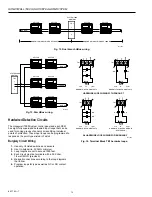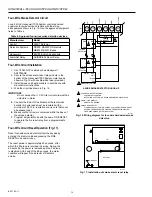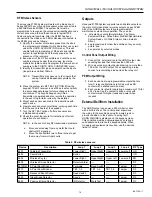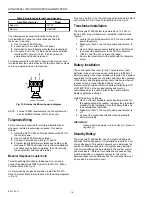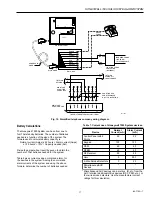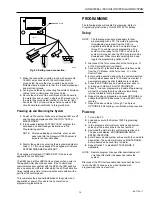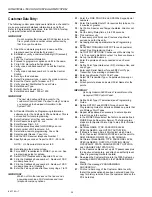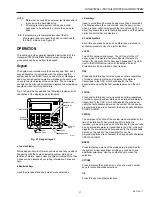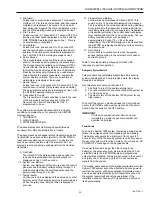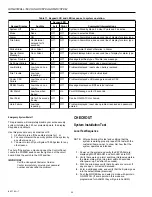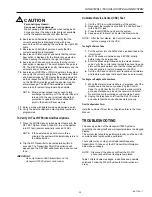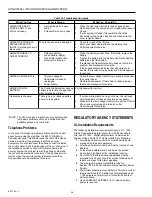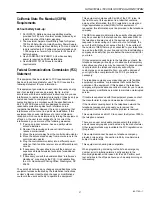
HONEYWELL 7000 SOLID STATE ALARM SYSTEM
69-1192—1
26
Table 12. Troubleshooting guide.
*NOTE: The CSC receives a signal from your system when
low battery problems occur, and notifies the first
available person on your call list.
Telephone Problems
In the event of telephone problems, disconnect the control
panel by removing the plug from the RJ31X (CA38A in
Canada) wall jack. This should leave the rest of the House
phones in service if the problem is with the security
equipment. Do not disconnect the phone connection inside
the control panel or the local phones will be out of service. If
the telephone service is still out after disconnecting the
security system the problem is with the phone system and
they should be contacted for service. If the phones service
returns when the security system is disconnected then
Honeywell should be contacted for service.
REGULATORY AGENCY STATEMENTS
UL Installation Requirements
The following installation requirements apply to UL - 1023 -
Grade A Household Burglar Alarm, for UL 985 Household
Fire, and UL 1635 - Digital Burglar Alarm Communicator
System Units, and UL 1637 Home Health Care Signaling:
1.
All wiring and interconnections must be owned and
managed by the same person(s).
2.
All wiring and interconnections must be located at one
address.
3.
At least one audible alarm device must be placed
where it can be heard at the installation location.
4.
Per NFPA72, Battery backup capabilities must be
provided for 24 hours of normal service followed by at
least 4 minutes of File Alarm signaling.
5.
The maximum Ampere Hour Battery load for
System 7000 is 28 AG without a Listed Auxiliary Power
Supply.
6.
The minimum Ampere Hour Battery is 7 AH and current
load is restricted to 210 milliamps normal standby and
1.185 amperes of alarm for 4 minutes for 24 hours of
battery backup.
7.
Use ALARM-SAF AP/PS5BF 12-UL when auxiliary
power is required.
What You See
What is Wrong
What You Should Do
HOME NOT READY
FORCE ARM? These
Points not ready.
1.
A protected point is open
and/or:
2.
A transmitter cover is open.
1.
Press the right arrow button to look at open points.
2.
Open and close the named door or window and leave it
closed.
3.
If your system includes rf transmitters, check the
transmitter at the named location and make sure the
cover is tightly closed.
HOME FIRE TROUBLE
SMOKE DETECTOR
(NOTE: A warning tone will
also sound.)
Wire to fire sensors is damaged.
1.
Check for signs of fire. If none:
2.
Enter your passcode to silence the warning tone.
3.
Call Honeywell for service.
HOME TROUBLE TX
GUEST WINDOW
1.
Defective battery.
2.
Loose battery lead(s).
3.
Transmitter malfunction.
4.
Receiver malfunction.
1.
Clean the battery connections. if this fails, replace the
battery.
2.
Tighten the battery and the battery clip. Reconnect the
battery and test the system.
3.
If replacing the transmitter battery does not solve the
problem, call Honeywell for service.
4.
If the keypad display indicates that all points are in
trouble, the receiver may be defective. Call Honeywell
for service.
HOME AC POWER FAIL
1.
The low voltage ac
transformer is loose or
unplugged.
2.
Power failure.
1.
Check the low voltage transformer usually located near
the control panel.
2.
Restore house power. If there has not been a power
failure, call Honeywell for service.
HOME SYS LOW
BATTERY
The Control Panel system backup
battery is defective or weakened
after extended ac failure.*
Call Honeywell for service.
No display is showing.
There is no ac or backup battery
power to the system.
1.
If only some lights are out in your home, check house
circuit breakers or fuses and restore as necessary.
2.
Make sure the low voltage transformer near the Control
Panel is securely plugged into an ac outlet.
3.
Call Honeywell for service.

